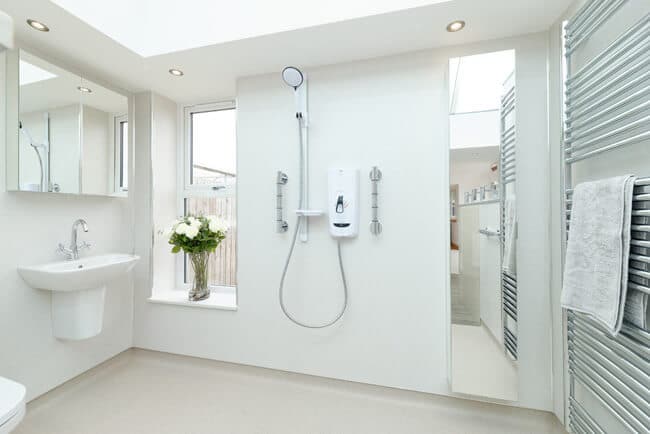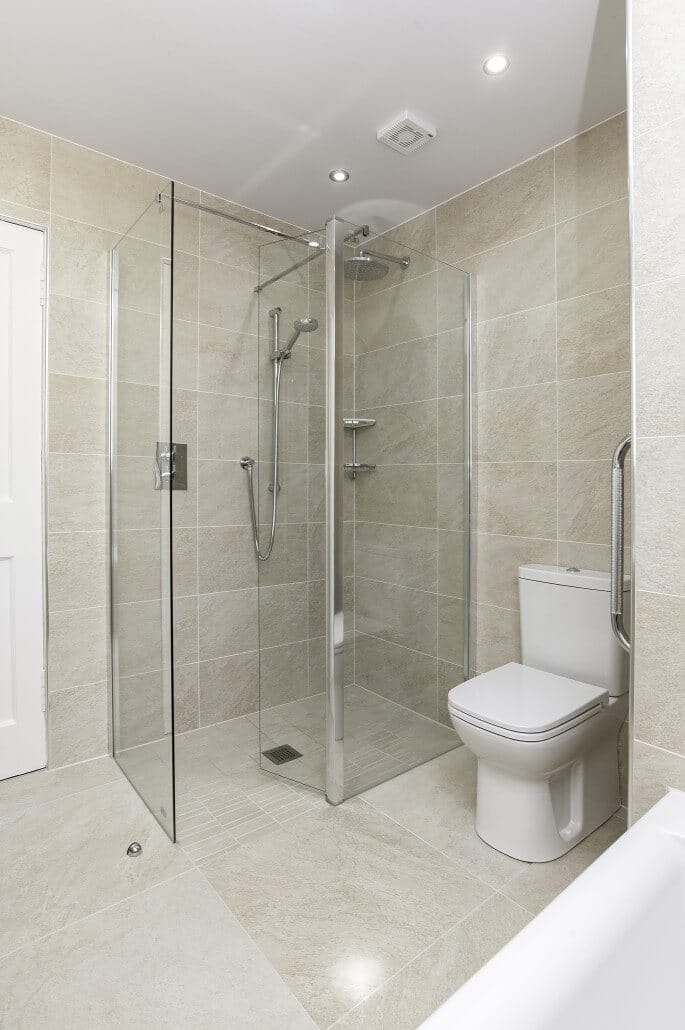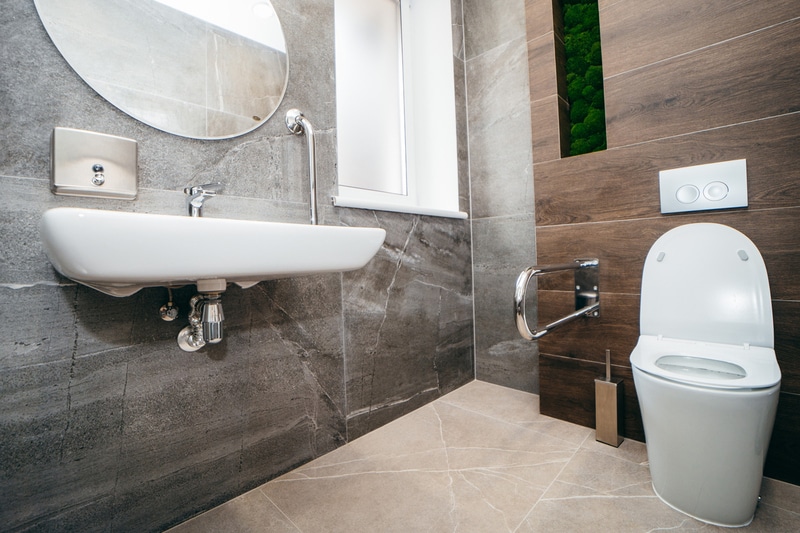A study done in 2019-20 showed that 8% of all UK households (1.9 million homes) had at least one person with a long-standing physical condition that required specialised aids and adaptions.
However, only 81% of those households felt that they had suitable support features in place. This means that around 374,000 UK households felt they had unsuitable accommodations for their mobility or condition.
The good news is that many customisable aids exist to create bathrooms for those with mobility issues or with disabilities. While there are standard adjustments you might have heard about, like handrails, there are also the following tailored solutions.
- Specialised bathroom adaptations
- Aids/adaptations for wheelchair users
- Aids for the visually impaired
- Other general aids and adaptions
Specialised bathroom adaptations
Walk-in showers
Installing a walk-in shower in your bathroom combines both functionality and style. These aren’t just showers for people with mobility issues, but for people who are looking for a more bespoke and luxurious bathing experience. They are typically more aesthetically pleasing and are more accessible than standard shower spaces.
Walk-in showers normally have a low elevated tray and often boasts one or two partitions. There are generally no doors, and it’s a deep enough shower to allow wider mobility needs. The benefits of this adaptation are:
- More practical when there’s a carer
- Allows for increased independence
- Looks elegant and stylish
Wet rooms
When you need something completely tailored for those with mobility issues, wet rooms are the ideal solution. The space doesn’t have trip hazards, as it’s designed with no lips or an elevated entry point.
Wet rooms also have drains on the floor, meaning you don’t need to struggle with any doors or shower curtains/partitions.
Wet rooms remain a stylish option since they follow a modern open-plan layout and save on bathroom space. All in all, it’s one of the most popular solutions available. As such, you can enjoy the following benefits:
- Ultra low easy-access for walking aids and other large mobility aids, such as wheelchairs
- Spacious enough to fit both you and a carer
Extra safety measures can be added seamlessly
Baths are supposed to be comfortable spaces where you can unwind, freshen up, and enjoy some quality time. However, we know that for many with disabilities or limited mobility, getting in and out of the bath can sometimes be very difficult.
Walk-in baths for elderly or disabled people are an ideal solution, as these designs feature a door on the side of the bath. These provide step-in access and allow you to take back your independence when it comes to bath time. Benefits include:
- Safer entry than a commercial bath
- Designed to provide comfort and relief to joint or muscle pain
- Various styles and options available
Aids/adaptations for wheelchair users
Of course, your bath and shower play a significant role in improving your bathroom experience. However, for people in wheelchairs, there’s an entirely separate problem to address, this being space.
We can provide a space where you can comfortably manoeuvre with your wheelchair, and the following bathroom adaptions will ensure you never need to navigate tight corners:
- Floating basins: With these, you can comfortably manoeuvre your wheelchair under the basin and at the right height. If you also ensure it’s height adjustable, then we make sure it’s fit for any family member of the household, even the kids!
- Benefit: Attractive look and multi-use for height-adjusting basin.
- Sliding doors: Sliding doors are excellent options for people who use wheelchairs as they’re far easier to handle and take up less space than a conventional door. You can go right through, as it’s also simple to adjust the door’s width.
- Benefit: Increased usability and provides more floor space.
Specialised toilets
We understand that going to the toilet can be difficult if you’re struggling with mobility. With specialised toilets, you’re one step closer to regaining your independence and staying comfortable in the process.
No matter what reason prevents you from using standard designs, there are specialised toilets that ensure a pleasant experience overall.
- Auto bidet wash and dry: Bidets are popular in various European countries like Italy, France and Portugal. While it’s not a common practice globally, it’s extremely hygienic, and this option is remote-controlled. It requires less manoeuvring and uses water features and warm air to wash and dry the user.
- Benefit: Full control over the cleaning process.
- Height-powered toilet: These toilets have adjustable heights to help you remain as comfortable as possible. They can be set to automatically lower and elevate your lower body, which is ideal if you’ve lost a lot of mobility and strength in that area.
- Benefit: Choice of tilts or seat designs, offering enhanced independence.
Aids for the visually impaired
In 2021, a study showed that over 2 million UK residents are visually impaired. Of them, nearly 80% are elderly people over 65. The other 20% are typically visually impaired due to genetics or injury. Whatever the case may be, we know that partial loss of sight can significantly impact mobility.
We’ve got good news here, too, as there are plenty of suitable bathroom adaptions:
- High-contrast taps and ceiling: To help you manoeuvre around your bathroom, you can implement contrasting colours, like black taps against white basins or white shower tiles against black taps. You can also add various textures, like wood tiling and stone floors, to help identify different sections of the bathroom.
- Benefit: Looks stylish and makes daily bathroom use easier.
- Voice-activated shower: Also known as the smart shower system, this aid makes showers for disabled people with sight loss an enjoyable experience. You can adjust the temperature and pressure with voice commands. Another option is to install an LED panel for manual control of the shower’s water and pressure.
- Benefit: Adds value to your property and allows for enhanced independence while showering.
Other general aids and adaptions
Bathroom and housing adaptations are seen as essential features in improving your quality of life and health. While we won’t go into detail, we’ll highlight a few common ones you might also be interested in using.
- Grab Rails and Assistance Poles: Rails and poles that you can grab onto as support.
- Slip-resistant Mats and Bath Cushions: Mats that prevent slipping on wet tiles. The bath cushions relieve pressure on your tailbone and lower back while bathing.
- Shower Seats and Bath Lifts: These seats allow you to sit down if you’re having trouble standing for long periods. Bath lifts help get you in and out of the bath.
- Emergency Pull String: Cords strategically placed in the bathroom that let you call for help.
Create an accessible space
We understand that requiring another’s help in the bathroom due to decreased mobility or disability can feel like a loss of control. However, with the above bathroom adaptions, you don’t necessarily need to have a carer with you.
Walk-in showers, walk-in baths and wet rooms all help you increase your independence in the bathroom. BMAS offers expert services to ensure you’re equipped with the best solution, and we cover multiple UK areas. Contact us to have a friendly chat about the right bathroom solution for your needs.





